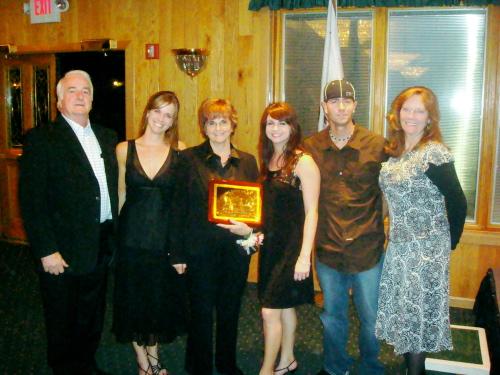- Elizabeth Larson
- Posted On
Geothermal plant neighbors air concerns, demand fixes
COBB – Representatives of a geothermal power plant on Cobb on Thursday got a loud message from area residents, who made it clear that they were tired of what they felt was a clear pattern of poor management and practices, and were determined that it should change.
The two-and-a-half-hour meeting, held at Cobb's Little Red Schoolhouse, brought a representative from Bottle Rock Power Plant face-to-face with nearly three dozen annoyed neighbors, who said they've been putting up with noise, speeding trucks, accumulated garbage, impacted water wells and other environmental issues for years, well before the plant reopened in March of 2007.
The plant is being operated under a use permit first granted in 1980 and valid until 2013.
Supervisor Rob Brown, who was first contacted by neighbors last year regarding noise issues, coordinated the meeting. He said he got involved last month, as complaints began to escalate.
Earlier in the day, he and a group toured the facility, which is owned by a partnership between US Renewables Group and Carlyle/Riverstone Renewable Energy Infrastructure Fund I.
Also at the Thursday meeting was Supervisor Ed Robey, who Brown invited because Robey has dealt with similar issues between Calpine and the Anderson Springs community; Community Development Director Rick Coel; Ron Yoder, the county's only associate resource planner; Ray Ruminski of Environmental Health; and Air Pollution Control Officer Doug Gearhart of the Lake County Air Quality Management District.
Larry Bandt, vice president of engineering for Oski Energy – which manages the plant for its owners – said another group, Integral Energy Management (IEM), runs the plant and its steamfield. Yet another company, ThermaSource of Santa Rosa – which is partially owned by US Renewables Group and Riverstone – does the operation's drilling.
“A lot of the issues started long before IEM took over steamfield operations,” said Bandt.
He added, “We don't really care who caused the problem,” and committed to working on solutions.
During the Thursday plant tour, Bandt said it became clear to him that concerns about what is in the sump ponds that collect materials from the plant's drills is one of the big issues. He said they plan to move those materials, test them and if they're hazardous to have them taken to an appropriate disposal facility.
Those sump materials already are tested, said Bandt, with samples collected by a plant staffer and sent to a lab.
“The first thing on these sumps is we need to clean them out,” he said. The plant is working on getting a permit to begin that process, which involves both state and local agencies.
Bandt admitted that the plant's staff also was responsible for some streambed disturbance, which was done with heavy equipment. He said they contacted the Department of Fish and Game to come up with a plan to repair the damage.
The agency instructed them to “button it up for the winter” to try to protect the area from erosion, and to conduct the creek restoration in the spring. “We're going to do that for sure, no question,” said Bandt.
Drill cuttings, which were spread in a meadow to dry, have been removed and the meadow revegetated, although some metal and other materials are still there. Bandt said they're committing to doing additional testing to make sure no hazardous materials are there.
As part of plant operations, Bandt said there was no grading plan because they only cleared brush from the roads that were there already. Roads that aren't needed won't be used.
He also conceded that there has been damage to High Valley Road, which runs past the plant, due to truck traffic. An outside contractor has been contacted to work on repairing the road, but the plant's operators don't want to start repairs until after some heavy equipment has been moved out.
Radar signs are being posted and plant employees will get one warning if they're caught speeding and will be terminated if caught a second time. Bandt said a company employee will monitor for speeding.
There also is an unpermitted pad by the steamfield, which the plant operator needs to either get a permit for or remove next spring, said Bandt.
The operation's sound has been one particularly vexing and unresolved issue according to residents, some of them reporting that said the sound travels down to Loch Lomond.
Bandt the company has an individual who will be a contact for residents regarding their complaints.
“Our residents have just lost all trust and faith in your promises,” said Gerri Finn, a High Valley Road resident since 1997.
That's why area residents contacted Brown and other county officials, Finn said. The person Bandt named “is not going to be our contact person,” she said. “We're well beyond working with Bottle Rock Power just because it's taken so long.”
The county, she added, would now be the contact for the community's complaints.
Bandt replied by telling the residents that one of the drill rigs was being dismantled and removed, which should reduce noise, and said he would work to get other measures implemented, agreeing to contact Brown with an update.
At Brown's suggestion, Bandt also agreed to allow a third party to take the sump samples in order to raise the residents' confidence in the testing.
Community member Robert Stark questioned Bandt about plans to expand the plant's current operations. Bandt said the plant is currently producing 11 megawatts of power, with a 55 megawatt capacity, and they only intend to drill two more wells.
“Aren't there plans to expand geothermal power further up into High Valley towards Mendocino?” asked Stark, to which Bandt said yes, but he noted those plans would take time to develop.
Stark suggested that the county needed to have a plan for dealing with geothermal expansion and a point person to monitor the associated issues.
Hamilton Hess, chair of the Friends of Cobb Mountain, agreed with the county appointing a single person for monitoring and coordination, and said Lake County Special Districts Administrator Mark Dellinger had done a good job at such a task in previous years.
Brown said he and Coel plan to sit down and discuss how to deal with geothermal operations, and he agreed with Stark that the county needs to get ready for more geothermal power generation.
Regarding the county's interaction with Bottle Rock Power, “The first priority has been to work with them to get the biggest problems resolved immediately,”said Coel. Those larger issues are grading, erosion control and the creek restoration.
He said Yoder has been up to the site as many as 10 times, and it was Yoder who brought in other agencies such as Fish and Game and the state water quality control board. “Those guys have a lot bigger hammer than us in terms of levying fines,” said Coel.
Community member Ron Fidge alleged that chromium six, a heavy metal compound, is leaking into the ground in the area due to the plant. “It needs to be dealt with, that's all I'm saying.”
Yoder said the chromium tested “right at the borderline for toxicity.”
Ruminski explained that the chromium wasn't brought to the site, but is comes out with the drilling materials. When a neighbor asked if it could pose a danger to his children, Ruminski replied, “It can be a hazard.”
Brown asked Ruminski if he had seen anything on the tour that day that posed a threat. “The simple answer to your question is, it depends,” Ruminski said.
Stark said it wasn't a fair question. Pointing to a picture of a pile of drilling materials Yoder showed in a slide presentation, Stark said the constant contamination of soil won't kill people tomorrow. “Your children's children will be affected.”
Yoder said he believed the answer to the neighbors' problems was the plant's compliance with its use permit.
“We all want compliance,” said Finn, but she said the pattern of noncompliance established so far doesn't leave them hopeful.
Yoder said he doesn't believe past practices always predict the future.
David Coleman, whose property is located directly east of the plant, showed his own slides of the area around the plant, and noted some spots have now been cleaned up where previously garbage had been piled. The use permit, he said, called for the property to be kept clean and neat.
Neighbors said one of their most serious concerns involved a virgin meadow with large oaks trees where some of the materials had been stored.
Another meeting will be held on Nov. 20 to follow up on the progress in resolving residents' complaints.
Coleman said afterward that he felt the meeting was productive, and had gotten the point across to the plant's operators that the neighbors were serious about finally getting resolution to their issues.
E-mail Elizabeth Larson at This email address is being protected from spambots. You need JavaScript enabled to view it..
{mos_sb_discuss:2}

















